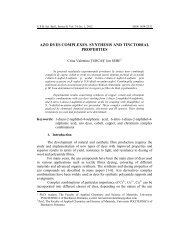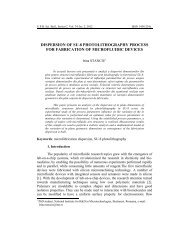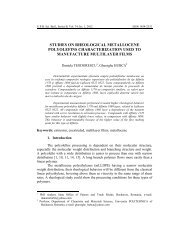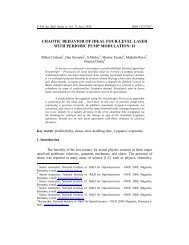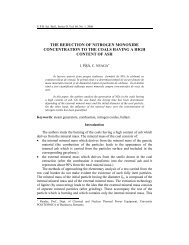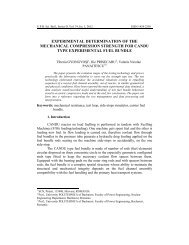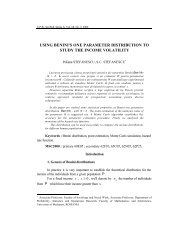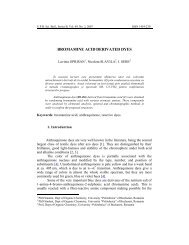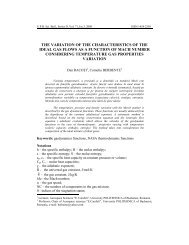poly bis-gma/ha based hybrid composite materials - Scientific Bulletin
poly bis-gma/ha based hybrid composite materials - Scientific Bulletin
poly bis-gma/ha based hybrid composite materials - Scientific Bulletin
Create successful ePaper yourself
Turn your PDF publications into a flip-book with our unique Google optimized e-Paper software.
78 Maria Ficai, Ecaterina Andronescu, Anton Ficai, Georgeta Voicu, Bogdan Ştefan Vasile<br />
Results and discussion<br />
The <strong>hybrid</strong> <strong>composite</strong> <strong>materials</strong> were c<strong>ha</strong>racterized by X-ray diffraction –<br />
XRD, Fourier transform infrared spectroscopy – FTIR, scanning electron<br />
microscopy – SEM, transmission electron microscopy – TEM and complex<br />
thermal analysis DTA-TG-DTG.<br />
3.1 X–ray diffraction<br />
X–ray diffraction was used to analyze the crystalline p<strong>ha</strong>ses of the<br />
<strong>composite</strong>s <strong>materials</strong>.<br />
The most important peaks of the <strong>composite</strong> material are identified (Fig. 2).<br />
These belong to the HA ( 25.7; 28.9; 31.8; 32.06; 32.98; 35.95; 39.89; 46,66;<br />
49,29) and to the brushite (22,96; 26,64; 30,33; 34.2). The presence of brushite<br />
can be explained <strong>based</strong> on the reaction 1, phosp<strong>ha</strong>te anions being resulted by<br />
hydroxyapatite solubilisation and brushite formation is due to<br />
hydrogenophosp<strong>ha</strong>te precipitation. Based on the recorded diffractogram it can be<br />
observed a good crystallinity of the mineral p<strong>ha</strong>ses.<br />
PO + H O HPO +H O (1)<br />
I, CPS<br />
3 − + pKa3 = 12.67<br />
2−<br />
4 3 4 2<br />
1700<br />
1600<br />
1500<br />
1400<br />
1300<br />
1200<br />
1100<br />
1000<br />
<strong>poly</strong> Bis-GMA/HA, thermal <strong>poly</strong>merization<br />
<strong>poly</strong> Bis-GMA/HA, chemical <strong>poly</strong>merization<br />
HA, ASTM [74-5066]<br />
900<br />
800<br />
700<br />
600<br />
500<br />
400<br />
300<br />
200<br />
100<br />
0<br />
10 20 30 40 50 60 70<br />
2Theta<br />
HA<br />
CaHPO 4<br />
Fig. 2. X-Ray diffraction pattern of <strong>poly</strong> Bis-GMA/HA <strong>composite</strong> material obtained by thermal<br />
and respectively chemical <strong>poly</strong>merization



